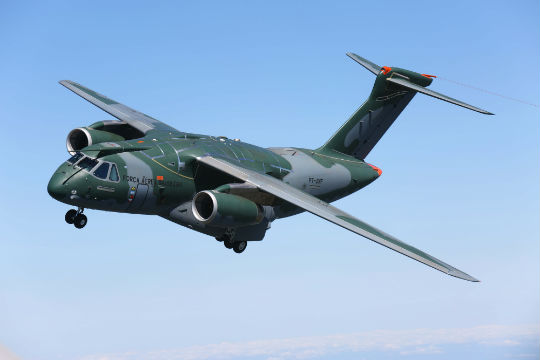By Ken Pole | December 23, 2015
Estimated reading time 5 minutes, 58 seconds.
Embraer’s heaviest model to date can carry up to 20 tonnes of cargo in a compartment 17.76 metres long, 3.45 metres wide and 2.9 metres high. Embraer Photo
Speed, range, payload and lifecycle costs are touted by Brazil’s Embraer as key attributes of its KC-390 military transport aircraft, which is now officially in the running for selection as Canada’s new fixed-wing search and rescue (FWSAR) platform.
Unlike its potential turboprop rivals, the KC-390 is a twin-engine jet conceived as a clean-sheet design in 2006. It was still in early development when Skies visited Embraer’s Sao Paulo facility in October 2012, but the company rolled out the first of two prototypes in just two years.
To do that, it drew on nearly a half-century of civil and military design, development and production expertise, according to Geraldo Gomes, vice-president of business development for Embraer Defense and Security.
“Development of the KC-390 made extensive use of advanced digital modelling technologies, test rigs and advanced manufacturing processes in order to anticipate any issue,” he explained in late December.
First flight was in February 2015 and that aircraft, about to be joined by the second prototype, is now halfway through 2,000 hours of flight test evaluation. Certification is expected in the second half of 2017, with entry into service in 2018.
Embraer’s heaviest model to date can carry up to 20 tonnes of cargo in a compartment 17.76 metres long, 3.45 metres wide and 2.9 metres high. Maximum cruising speed is 860 kilometres per hour, maximum range is 4,815 kilometres, and it has a 10,973-metre service ceiling.
Confirming Embraer’s plans to submit a FWSAR proposal by the Jan. 11, 2016, deadline, Gomes told Skies the KC-390 features the latest avionics, electro-optic/infrared and radar sensors, full night-vision-goggle capability, and fly-by-wire technology, which enables the crew to focus on the mission.
The KC-390 is powered by International Aero Engines V2500-E5 turbofans, the first military application of the powerplants found in the larger Airbus A320s. Embraer Photo
He said the KC-390 would be “the ideal aircraft” for the mission because it can not only be flown high and fast, but also low and slow, a Brazilian Air Force (BAF) requirement for paratrooper drops and in-flight refuelling of helicopters. Factor in its range and that it was “SAR-ready from the initial concept,” and that “fast reconfiguration allows the plane to act as a fast transport for injured victims with litters and life-support equipment.”
Gomes pointed out that the BAF’s SAR environments are similar to Canada’s, including dense forest, mountains and large maritime areas. “The sooner you get to the search area, the higher the chances of success,” he noted.
The KC-390 is powered by International Aero Engines V2500-E5 turbofans, the first military application of the powerplants found in the larger Airbus A320s; and while test evaluation is “progressing well,” none of it has involved austere airstrips. Even so, Gomes said “the ability to operate from unpaved or contaminated runways has been an integral part of the design requirements.”
Other key suppliers include two U.S. majors—Rockwell Collins (avionics and cargo-handling and aerial delivery system) and Goodrich Corp. (primary fly-by-wire)—as well as the venerable Czech firm Aero Vodochody (aft fuselage).
Although Embraer has talked with potential Canadian partners about spinoffs from the $3 billion procurement, including 20 years of in-service support, Gomes said only that, “Embraer will deliver a competitive, custom-made solution for Canada and this will certainly include local participation.”
As for lifecycle costs, Gomes insists the KC-390’s are the lowest in its class.
“The latest maintainability processes and tools allow the aircraft to operate with a longer time between inspections and reduced maintenance downtime,” he said. “The KC-390 uses mature solutions like proven engines, commercial off-the-shelf basic avionics and integrated fault monitoring. It also introduces new technologies to the medium airlift category such as prognostic health monitoring and advanced structural health monitoring.”
Embraer currently has 28 firm orders from the BAF, which will also acquire the two prototypes, having put up the equivalent of $1.5 billion in initial funding. Argentina, the Czech Republic and Portugal (which also contributed to the $2 billion development cost) have signed letters of intent, as have Chile and Colombia. If all translate into firm orders, the total would be 60 aircraft, excluding the prototypes.
Canadian selection would give the company a foothold in North America, a key element of Embraer’s goal to secure “a good share” of what Gomes called the “addressable replacement market” of some 700 medium-airlift transports worldwide by 2030.



